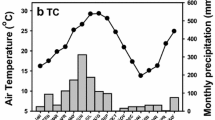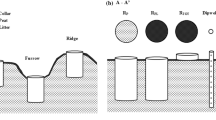Abstract
Data on carbon fluxes such as soil respiration are needed to develop strategies for increased carbon sequestration and reduced levels of atmospheric trace gases. Soil respiration is driven by proximal factors (e.g., soil temperature and soil moisture), which affect soil respiration by regulating microbial and root activity, and distal factors (e.g., topography), which affect soil respiration by influencing proximal factors. The objectives of this study were: (1) to relate measured carbon dioxide flux from forest soils to proximal and distal factors; and (2) to develop predictive soil-landscape models of soil respiration across a forested watershed. Carbon dioxide flux from the soil surface was measured monthly for 12 months at sampling points selected using a random stratified approach, with strata established based on slope aspect (NE and SW), slope shape (concave and convex), and slope position (upper, middle, and lower backslope). We generated empirical models using robust linear regression techniques to examine relationships between soil respiration and both proximal (soil physical and chemical properties) and distal factors (terrain attributes calculated from a 30-m digital elevation model). In situ soil respiration rates were greater on the NE-facing slopes than the SW-facing slopes. The models that we developed and validated explain up to 66% of variability in measured soil respiration, although seasonal model relationships varied. Soil temperature was the most consistent proximal factor for predicting soil respiration rates, while slope aspect was the most consistent distal factor among the models.

Similar content being viewed by others
References
R. D. Bowden K. M. Newkirk G. M. Rullo (1998) ArticleTitleCarbon dioxide and methane fluxes by a forest soil under laboratory-controlled moisture and temperature conditions. Soil Biology and Biochemistry 30 1591–1597 Occurrence Handle10.1016/S0038-0717(97)00228-9 Occurrence Handle1:CAS:528:DyaK1cXkvV2ntbc%3D
J. M. Bremner (1996) Nitrogen-total. D. L. Sparks Particle, and others (Eds) Methods of soil analysis, part 3. Chemical methods. Soil Science Society of America Madison, Wisconsin 1085–1121
F. Chamran P. E. Gessler O. A. Chadwick (2002) ArticleTitleSpatially explicit treatment of soil-water dynamics along a semiarid catena. Soil Science Society of America Journal 66 1571–1583 Occurrence Handle1:CAS:528:DC%2BD38Xnt1GrtLo%3D
J. M. Craine D. A. Wedin F. S. Chapin (1999) ArticleTitlePredominance of ecophysiological controls on soil CO2 flux in a Minnesota grassland. Plant and Soil 207 77–86 Occurrence Handle10.1023/A:1004417419288
Cremeans, D.W. 1992. Dissertation. Aspect and slope position effects on moisture regime and properties of forest soils in eastern KY. University of Kentucky, Lexington, Kentucky
D. P. Franzmeier E. J. Pedersen T. J. Longwell J. G. Bryne C. K. Losche (1969) ArticleTitleProperties of some soils in the Cumberland Plateau as related to slope aspect and position. Soil Science Society of America Proceedings 33 755–761
J. C. Gallant J. P. Wilson (2000) Primary topographic attributes. J. P. Wilson J. C. Gallant (Eds) Terrain analysis. John Wiley & Sons New York 51–85
W. H. Gardner (1986) Water content. A. Klute (Eds) Methods of soil analysis, part 1. Physical and mineralogical methods. Soil Science Society of America Madison, Wisconsin 493–544
P. E. Gessler I. D. Moore N. J. McKenzie P. J. Ryan (1995) ArticleTitleSoil-landscape modeling and spatial prediction of soil attributes. International Journal of Geographical Information Systems 9 421–432
P. E. Gessler O. A. Chadwick F. Chamran L. D. Althouse K. W. Holmes (2000) ArticleTitleModeling soil-landscape and ecosystem properties using terrain attributes. Soil Science Society of America Journal 64 2046–2056 Occurrence Handle1:CAS:528:DC%2BD3MXhsFSluw%3D%3D
C. P. Giardina M. G. Ryan (2002) ArticleTitleTotal belowground carbon allocation in a fast-growing Eucalyptus plantation estimated using a carbon balance approach. Ecosystems 5 487–499 Occurrence Handle10.1007/s10021-002-0130-8 Occurrence Handle1:CAS:528:DC%2BD38Xnt1WntL4%3D
R. C. Graham R. B. Daniels S. W. Buol (1990) ArticleTitleSoil-geomorphic relations on the Blue Ridge Front: I. Regolith types and slope processes. Soil Science Society of America Journal 54 1362–1367
Hayes, R.A. 1998. Soil Survey of Breathitt County, Kentucky. Natural Resources Conservation Service, United States Department of Agriculture, Washington, DC
P. Högberg A. Nordgren N. Buchmann A. F. S. Taylor A. Ekblad M. N. Högberg G. Nyberg M. Ottosson-Löfvenius D. J. Read (2001) ArticleTitleLarge-scale forest girdling shows that current photosynthesis drives soil respiration. Nature 411 789–792 Occurrence Handle10.1038/35081058 Occurrence Handle11459055
R. B. Hutchins R. L. Blevins J. D. Hill E. H. White (1972) ArticleTitleThe influence of soils and microclimate on vegetation of forested slopes in eastern Kentucky. Soil Science 121 234–241
I. A. Janssens A. S. Kowalski B. Longdoz R. Ceulemans (2000) ArticleTitleAssessing forest soil CO2 efflux: an in situ comparison of four techniques. Tree Physiology 20 23–32 Occurrence Handle12651523
C. E. Johnson J. J. Ruiz-Mendez G. B. Lawrence (2000) ArticleTitleForest soil chemistry and terrain attributes in a Catskills watershed. Soil Science Society of America Journal 64 1804–1814 Occurrence Handle1:CAS:528:DC%2BD3cXntlGlsrc%3D
P. A. Matson R. C. Harriss (1995) Trace gas exchange in an ecosystem context: Multiple approaches to measurement and analysis. P. A. Matson R. C. Harriss (Eds) Biogenic gas fluxes: measuring emissions from soil and water. Blackwell Science Cambridge Massachusetts 1–13
A. Mehlich (1984) ArticleTitleMehlich 3 soil test extractant: A modification of the Mehlich 2 extractant. Communications in Soil Science and Plant Analysis 15 1409–1416 Occurrence Handle1:CAS:528:DyaL2MXhvVChsro%3D
I. D. Moore P. E. Gessler G. A. Nielsen G. A. Peterson (1993) ArticleTitleSoil attribute prediction using terrain analysis. Soil Science Society of America Journal 57 443–452
D. W. Nelson L. E. Sommers (1996) Total carbon, organic carbon, and organic matter. D. L. and others Sparks (Eds) Methods of soil analysis, part 3. Chemical methods. Soil Science Society of America Madison, Wisconsin 961–1010
J. Neter W. Wasserman M. H. Kutner (1989) Applied linear regression models. 2nd ed. Richard D. Irwin Homewood, Illinois
P. J. Rousseeuw A. M. Leroy (1987) Robust regression and outlier detection. John Wiley & Sons New York
M. E. Summer W. P. Miller (1996) Cation exchange capacity and exchange coefficients. D. L. and others Sparks (Eds) Methods of soil analysis, part 3. Chemical methods. Soil Science Society of America Madison, Wisconsin 1201–1229
G. W. Thomas (1996) Soil pH and soil acidity. D. L. and others Sparks (Eds) Methods of soil analysis, part 3. Chemical methods. Soil Science Society of America Madison, Wisconsin 475–490
J. A. Thompson J. C. Bell C. A. Butler (1997) ArticleTitleQuantitative soil-landscape modeling for estimating the areal extent of hydromorphic soils. Soil Science Society of America Journal 61 971–980 Occurrence Handle1:CAS:528:DyaK2sXjvVOqsbg%3D
J. A. Thompson J. C. Bell C. A. Butler (2001) ArticleTitleDigital elevation model resolution: Effects on terrain attribute calculation and quantitative soil-landscape modeling. Geoderma 100 67–89 Occurrence Handle10.1016/S0016-7061(00)00081-1
H. Tiessen C. Feller E. V. S. B. Sampaio P. Garin (1998) ArticleTitleCarbon sequestration and turnover in semiarid savannas and dry forest. Climatic Change 40 105–117 Occurrence Handle10.1023/A:1005342932178 Occurrence Handle1:CAS:528:DyaK1cXmslWgu7s%3D
J. P. Wilson J. C. Gallant (2000) Digital terrain analysis. J. P. Wilson J. C. Gallant (Eds) Terrain analysis. John Wiley & Sons New York 1–27
D. R. Zak W. E. Holmes N. W. MacDonald K. S. Pregitzer (1999) ArticleTitleSoil temperature, matric potential, and the kinetics of microbial respiration and nitrogen mineralization. Soil Science Society of America Journal 63 575–584 Occurrence Handle1:CAS:528:DyaK1MXks1ajtb0%3D
L. M. Zibilski (1994) Carbon mineralization. R. W. and others Weaver (Eds) Methods of soil analysis, part 2. Microbiological and biogeochemical properties. Soil Science Society of America Madison, Wisconsin 835–863
Author information
Authors and Affiliations
Corresponding author
Rights and permissions
About this article
Cite this article
Abnee, A., Thompson, J. & Kolka, R. Landscape Modeling of In Situ Soil Respiration in a Forested Watershed of Southeastern Kentucky, USA . Environmental Management 33 (Suppl 1), S168–S175 (2004). https://doi.org/10.1007/s00267-003-9127-0
Published:
Issue Date:
DOI: https://doi.org/10.1007/s00267-003-9127-0




